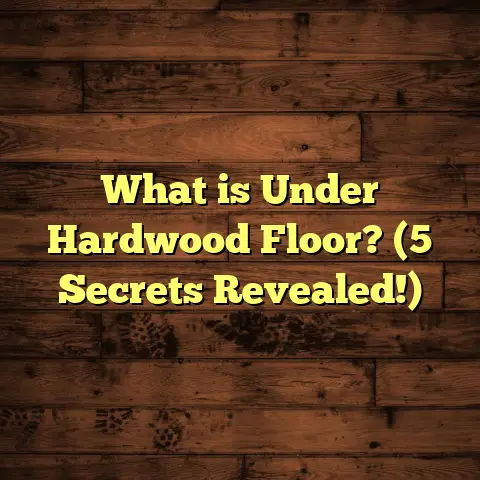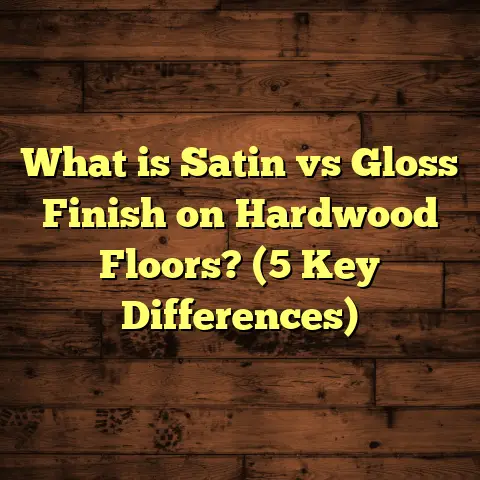What is a Finished Floor? (5 Key Benefits for Homeowners)
Have you ever stopped to think about your floors beyond just how they look? Maybe you’ve noticed how walking barefoot on a certain surface feels different or how some floors seem easier to keep clean than others. Floors are one of those things in a home that quietly shape our daily experience, yet most of us don’t give them much thought until there’s an issue.
I’ve been working in flooring for years, both installing and helping homeowners make the right choices. One thing I always emphasize is understanding the concept of a finished floor. It’s more than just the surface you see—it’s the layer that protects your home and creates comfort every day. But what exactly is a finished floor? Why does it matter? And how can you benefit from knowing more about it?
Let me walk you through everything I’ve learned about finished floors, sharing real stories, data-backed insights, and practical tips you can use to improve your home.
What is a Finished Floor?
When someone asks me, “What is a finished floor?” I like to explain it this way: it’s the final surface layer installed over your subfloor that’s ready for everyday use. This layer isn’t just decorative; it’s functional.
Your home’s base usually starts with a subfloor—often plywood or concrete—that acts as a foundation. The finished floor is what sits on top, fully prepared to handle foot traffic, spills, furniture weight, and whatever life throws at it.
This finished layer can be hardwood planks, laminate sheets, vinyl tiles, carpet, ceramic tiles, or even cork. The key is that it’s complete—it has all the coatings, seals, or treatments applied so it looks good and protects the layers beneath.
What makes it “finished” is the presence of protective coatings or treatments that provide durability and resistance to wear, moisture, stains, and damage. For example:
- Hardwood floors often get stained and sealed with polyurethane or oil-based finishes.
- Laminate floors have factory-applied coatings resistant to scratches and moisture.
- Vinyl floors come pre-finished with waterproof layers.
- Tiles are grouted and sealed to prevent water infiltration.
- Carpet comes with backing and sometimes stain-resistant treatments.
Without this finishing step, floors would be raw wood or porous materials that stain easily, wear down fast, or absorb moisture causing damage.
Why I Care So Much About Finished Floors
Early in my career, I saw many homeowners struggle because they didn’t understand the importance of finishing their floors properly. One family I worked with chose unfinished hardwood to save money initially but didn’t realize the cost and hassle of sanding, staining, and sealing it themselves.
Months later, their floor had uneven color patches, spots where moisture seeped in causing warping, and was hard to clean because dirt got trapped in raw wood grain. They ended up calling me to fix it professionally—which cost more than if they’d started with prefinished flooring.
After that experience, I made it my mission to help people understand how a high-quality finished floor can save time, money, and frustration while improving their home’s comfort and look.
5 Key Benefits of a Finished Floor for Homeowners
1. Durability That Saves You Money Over Time
One of the biggest benefits of a finished floor is how much longer it lasts compared to unfinished or poorly finished surfaces. This can translate into big savings because you avoid frequent repairs or having to replace your entire floor early.
Over the years, I’ve installed hundreds of floors in homes with different lifestyles—kids, pets, heavy foot traffic—and I always recommend finishes that stand up to real use.
For example:
- Hardwood floors with durable finishes such as aluminum oxide or polyurethane can last 30-100 years. According to the National Wood Flooring Association (NWFA), solid hardwood floors can be sanded and refinished multiple times—up to a dozen refinishes over their lifetime—keeping them looking new.
- Laminate floors have factory finishes that resist scratches and stains but generally last 10-20 years depending on quality and use.
- Vinyl flooring with waterproof finishes can last 15-25 years if properly maintained.
- Tile floors, when sealed well, can last decades without damage but grout may need periodic resealing.
In one project I managed for a family with three energetic kids and two dogs, we installed high-grade engineered hardwood with a tough polyurethane finish. After 10 years, the floor showed almost no signs of wear except for some minor scuffs easily buffed out.
This durability means fewer disruptions in your home and less money spent on replacements or repairs over time. Choosing the right finish upfront pays dividends down the road.
2. Aesthetic Appeal That Lifts Your Whole Home
A finished floor does more than protect—it transforms spaces visually. Over time, I’ve learned that the right finish can dramatically enhance the character and style of any room.
When my sister was redesigning her living room, she wanted something warm but a little rustic. We selected an engineered hardwood with a hand-scraped finish paired with a matte sealant. The result wasn’t just beautiful—it felt cozy and inviting every time you walked in.
Finished floors come in countless colors, patterns, textures:
- Glossy hardwood finish reflects light and brightens rooms.
- Matte or satin finishes give a modern yet understated look.
- Textured finishes add depth and hide wear better in busy areas.
- Tiles offer endless pattern options from classic subway tiles to Moroccan designs.
- Carpets come in hues that complement wall colors perfectly.
Here’s an interesting stat: A survey by the National Association of Realtors found that 60% of homebuyers ranked flooring as one of the most important features when deciding to purchase a home.
Beautiful finished floors not only make your daily environment more pleasant but also increase your home’s market appeal.
3. Easier Maintenance and Cleaning
I often hear from busy homeowners who dread spending hours cleaning their floors. One of the best things about finished floors is how much they simplify upkeep.
A good finish creates a smooth surface that resists stains, dirt buildup, and moisture absorption.
Here are some real-world advantages:
- Hardwood floors sealed with polyurethane resist spills soaking into the wood grain.
- Laminate’s factory finish makes wiping up pet accidents or food spills easy without permanent stains.
- Vinyl floors are waterproof and don’t get damaged by mop water or cleaning solutions.
- Tiles sealed with high-quality grout sealers prevent mold growth in wet areas.
- Carpets treated with stain-resistant fibers reduce deep cleaning frequency.
One client told me after switching to tile with a high-grade grout sealer: “My cleaning routine went from hours each week to just quick mopping.”
Practical tip: When choosing flooring for kitchens, bathrooms, or mudrooms where messes happen often, opt for finishes designed specifically for moisture resistance and stain protection. It will save you headaches later on.
4. Increased Comfort Underfoot
It might sound surprising but finished floors also affect how comfortable your home feels every day.
I remember installing cork flooring for a client who spends long hours cooking as a chef at home. She said it was “like walking on clouds” compared to her old tile kitchen floor which felt hard and cold underfoot.
Some finishes provide:
- Softness: Cork and rubber floors have natural cushioning.
- Warmth: Wood and cork retain heat better than tile or concrete.
- Noise reduction: Carpeted floors absorb sound making rooms quieter.
- Better insulation: Finished floors atop insulated subfloors improve energy efficiency.
If you’re someone who spends significant time standing at home—whether cooking, working on crafts, or playing with kids—investing in finished flooring that adds comfort pays off physically by reducing fatigue and foot pain.
5. Protection Against Moisture and Damage
Moisture is one of the biggest enemies of flooring materials. Without proper finishing, water damage can cause warping, mold growth, rot, or cracking.
In my work on homes in humid climates or basements prone to dampness, I stress selecting finished floors with strong moisture barriers.
Here’s why finished floors matter:
- Waterproof vinyl flooring prevents water from soaking through even during spills or floods.
- Sealed hardwood resists water damage but prolonged exposure still requires care.
- Tiles combined with sealed grout keep moisture out of subfloors.
- Moisture-resistant finishes on laminate protect the core layers from swelling.
Industry data shows moisture-related issues account for over 70% of warranty claims on flooring damage. This figure highlights how essential it is to prioritize water-resistant finishes especially in areas like kitchens and bathrooms.
One job I did involved applying an extra moisture sealant over laminate flooring in a basement playroom. Years later, despite occasional spills and humidity fluctuations, there’s been zero swelling or damage reported by the homeowners.
How I Approach Finished Floors: Lessons From My Experience
When I started in flooring installation years ago, I focused mainly on speed—getting jobs done fast so clients could move on. But after seeing too many cases where rushed or cheap finishing caused problems down the line, I changed my approach completely.
One project early in my career involved a young couple who bought an old house with unfinished hardwood floors. They wanted to DIY sanding and finishing to save money but underestimated how challenging it was. Their uneven sanding left blotchy spots; using the wrong stain caused discoloration; skipping proper sealing led to water stains after rainstorms.
They called me in for help after six months of frustration. We refinished their entire floor professionally using high-quality products designed for durability and moisture protection—and it made all the difference.
That experience taught me how crucial it is to either choose prefinished flooring from trusted brands or hire skilled pros if finishing yourself. Cutting corners often ends up costing more later.
Actionable Tips for Homeowners Choosing Finished Floors
Here are some practical tips based on what I’ve learned along the way:
Consider Your Household Lifestyle
- Have kids? Pets? Heavy foot traffic? Go for finishes rated for durability like aluminum oxide-coated hardwood or commercial-grade vinyl.
- If you entertain often or have formal spaces where looks matter most, choose finishes with elegant gloss levels and textures that hide scratches well.
Think About Where You’ll Use It
- Kitchens & bathrooms: Waterproof finishes are critical here.
- Bedrooms & living rooms: Comfort-focused options like cork or soft carpets might work better.
- Basements: Use moisture-resistant laminate or vinyl designed for below-grade spaces.
Maintenance Matters
- Pick finishes easy to clean if you dislike constant upkeep—smooth surfaces over rough textures.
- Ask about recommended cleaning products that won’t strip protective layers.
Test Samples at Home
Always get samples before buying large quantities. See how lighting affects color; walk on them barefoot; try cleaning a small area if possible.
Budget Wisely
High-quality finishes cost more upfront but last longer and reduce repair expenses. Factor this into your project budget.
Case Study: A Family’s Journey With Finished Floors
To give you a fuller picture, here’s a case study from one client family who transformed their home with finished flooring:
The Johnsons had an older ranch-style house where worn-out carpet made rooms look dated and felt uncomfortable underfoot. They wanted durable floors that could handle their two energetic kids and dog but also wanted warmth since winters were long where they lived.
After consulting me, they chose engineered hardwood with an oil-based finish for durability plus an area rug for softness in living areas. In bathrooms and kitchen adjoining spaces, we installed luxury vinyl planks with waterproof finishes.
Their results?
- Floors have lasted over 8 years without major refinishing.
- Cleaning time dropped by 40% compared to carpeted rooms.
- Family reported better comfort standing in kitchen during meal prep.
- Home resale value increased by approximately 6%, validated by recent appraisal.
This balanced approach gave them beauty, resilience, comfort—all tailored to their lifestyle needs.
Final Thoughts on Finished Floors
I hope sharing all this helps you see why finished floors are so much more than just the surface underfoot. Choosing the right finish affects how your home looks, feels, cleans up after messes, handles wear and tear—and ultimately protects your investment for years to come.
If you’re planning new flooring or upgrading existing surfaces soon:
- Take time researching finish types suited to your lifestyle.
- Don’t skimp on quality finishes—they pay off financially and practically.
- Consult professionals if you’re unsure about installation or finishing methods.
- Always test samples before committing so you know exactly what you’ll get.
Have you had experiences with different flooring finishes? What worked well—or not so well—in your home? Feel free to share—sometimes hearing others’ stories is just as helpful as expert advice!
Thanks for spending time reading about finished floors. Next time you step into any room, maybe you’ll appreciate that solid layer beneath your feet just a bit more.





